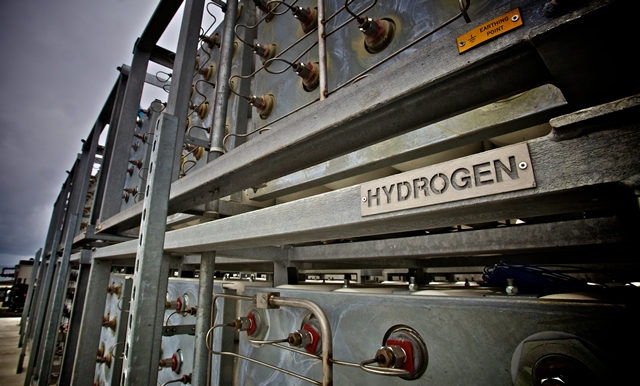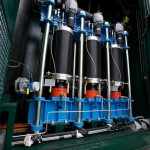Press release: World’s first tidal-powered hydrogen generated at EMEC

EMEC hydrogen storage cylinders (Credit Colin Keldie)
EMEC has generated green hydrogen gas demonstrating potential for a clean replacement for polluting fuels
The European Marine Energy Centre (EMEC) has produced hydrogen gas using electricity generated from tidal energy in Orkney.
This is the first time that hydrogen has been created from tidal energy anywhere in the world.
The first tidal-powered hydrogen was generated by EMEC on Friday 25th August 2017.
By harnessing the power of the tide at EMEC’s tidal energy test site at the Fall of Warness, Eday, Orkney, prototype tidal energy converters – Scotrenewables’ SR2000 and Tocardo’s TFS and T2 turbine – fed power into an electrolyser situated next to EMEC’s onshore substation.
Supplied by ITM Power, the electrolyser uses the electricity to split water (H2O) into its component parts – hydrogen (H2) and oxygen (O2).
The electrolyser is housed in a standard 20’ by 10’ ISO container with hydrogen generation capacity of up to 220kg/24hours.
EMEC’s investment in hydrogen production capability has been made possible by funding of £3 million from Scottish Government, made available through Highlands and Islands Enterprise.
Scottish Minister for Business, Innovation and Energy Paul Wheelhouse said:
“The Scottish Government is pleased to be supporting this innovative project which will help to partially overcome grid constraints in the Orkney Islands by enabling the storage of excess tidal power generated and using that electricity to produce hydrogen. The project also adds to our growing understanding of the potential role of hydrogen in Scotland’s future energy system – something we have committed to exploring in our draft Energy Strategy.”
Neil Kermode, Managing Director of EMEC, said:
“The electrolyser was set up to pilot the production of hydrogen fuel from tidal energy – and now we’ve done just that. This is a tremendous milestone for us and thanks must go to EMEC’s staff, the Scottish Government, Highlands and Islands Enterprise, ITM Power and Bryan J Rendall Electrical for helping make this happen.
“Whilst the initial driver behind buying an electrolyser was to provide a storage solution to circumvent local grid constraints, the purchase has sparked off other pioneering projects around Orkney looking to use hydrogen in various means. So we’re now looking towards the development of a hydrogen economy in Orkney.
“One of the most promising uses of hydrogen is as a fuel for transport as it emits no carbon when it is consumed and, providing it’s generated by clean renewable energy sources, it becomes a carbon neutral fuel source. Therefore, we could see green hydrogen, over time, replace polluting fuels in our cars, vans and ferries.”
ITM Power, who specialise in the manufacture of integrated hydrogen energy systems, won a competitive tender to supply a system to EMEC back in 2015. The system’s principal component, a 0.5MW ‘polymer electrolyte membrane’ (PEM) electrolyser, comes with integrated compression and up to 500kg of storage.
Dr Graham Cooley, CEO, ITM Power commented:
“We are delighted to be working with EMEC and to have reached the milestone of first gas production on this ground-breaking project to directly couple an electrolyser to tidal turbines. This is an excellent example of using hydrogen to capture and store excess renewable energy.”
One of the projects that will be using EMEC’s electrolyser is the Surf’n’Turf project being led by Community Energy Scotland in partnership with Orkney Islands Council, EMEC, Eday Renewable Energy and ITM Power.
The Surf ‘n’ Turf project will see the electrolyser producing hydrogen using electricity from EMEC’s test site as well as power from a 900kW Enercon wind turbine owned by the Eday community. The hydrogen will then be transported to Kirkwall, where a fuel cell installed on the pier will convert the hydrogen back into electricity for use as auxiliary power for ferries when tied up overnight. The project is also developing a training programme with a view to green hydrogen eventually being used as a fuel source on the inter-island ferries themselves.
Mark Hull, Community Energy Scotland’s Head of Innovation said:
“As Orkney’s communities and businesses pull together to establish the foundations of a local hydrogen network, it’s fantastic to see this achievement. Getting the most out of the islands’ renewable resources is the driving force behind the Surf ‘n’ Turf project of which this electrolyser is a key part.
“So it’s full speed ahead now to get the rest of the network ready.”
Bryan Rendall, Director at BJRE Ltd said:
“This has been a fantastic opportunity for us to get involved in yet another world leading project, and we have been instrumental in many aspects of it; from electrical system design through to commissioning. We are delighted to have worked with so many of the project partners including Eday Renewable Energy, EMEC, ITM Power and Community Energy Scotland and to have had so much support from the people on Eday.
“We are really looking forward to seeing more and more hydrogen infrastructure in Orkney to complement the renewable energy electrical infrastructure we have built out over the last 18 years. There are tremendous opportunities for us all here in Orkney to adopt an alternative and complementary means of energy distribution and use. We are proud to have been part of progressing that thus far, and look forward to seeing much more of it in the future.”

Surf ‘n’ Turf graphic









